Comparison and Analysis of Detection Methods for Typhoon-Storm Surges Based on Tide-Gauge Data—Taking Coasts of China as Examples
Abstract
:1. Introduction
2. Materials and Methods
2.1. Data
2.1.1. Tide Gauge (TG) Data
2.1.2. NCEP-Reanalysis Air-Pressure Data
2.1.3. Historical Typhoon-Storm-Surge Events (Historical Statistics)
2.2. Method
2.2.1. Data Pre-Processing of Tide-Gauge Stations
2.2.2. Storm-Surge-Event Detection and Identification Method
- Pauta Criterion
- 2.
- Chauvenet Criterion
- 3.
- Pareto Distribution
- 4.
- Kurtosis Coefficient
- 5.
- Storm-Surge-Event-Identification Algorithm
2.2.3. Comprehensive Evaluation Indicators
3. Results
3.1. Feasibility Analysis of the Four Methods
3.2. Capability Evaluation of the Four Methods for Detecting Storm-Surge Events
3.2.1. Preliminary Capability Evaluation of the Four Methods for Detecting Storm-Surge Events
3.2.2. Comprehensive Capability Evaluation of the Four Methods for Detecting the Storm-Surge Events
3.3. Detection Results of Typical Storm Surges Detected by the Four Methods
4. Discussion
4.1. The Detection Results of CC and PD Were Less Influenced by the Extratropical-Storm Surges
4.2. Evaluation of the Four Detection Methods
4.2.1. Analysis of False-Detection Results
4.2.2. Comprehensive Capability Evaluation
4.2.3. Detection Capability of Typical Storm Surge
5. Conclusions
Author Contributions
Funding
Institutional Review Board Statement
Informed Consent Statement
Data Availability Statement
Acknowledgments
Conflicts of Interest
References
- Lowe, J.A.; Gregory, J.M.; Flather, R.A. Changes in the occurrence of storm surges around the United Kingdom under a future climate scenario using a dynamic storm surge model driven by the Hadley Centre climate models. Clim. Dyn. 2001, 18, 179–188. [Google Scholar] [CrossRef]
- Pugh, D.T. Tides, Surges and Mean Sea Level; John Wiley Sons: Hoboken, NJ, USA, 1987; p. 472. [Google Scholar]
- Wang, Y.; Zhao, J.; Mu, J. Analysis of Residual Water Level Using Interval Meteorological Data. Hydrogr. Surv. Charting 2015, 35, 45–47. [Google Scholar]
- Muis, S.; Verlaan, M.; Winsemius, H.C.; Aerts, J.C.J.H.; Ward, P.J. A global reanalysis of storm surges and extreme sea levels. Nat. Commun. 2016, 7, 11969. [Google Scholar] [CrossRef]
- Syvitski, J.P.M.; Kettner, A.J.; Overeem, I.; Hutton, E.W.H.; Hannon, M.T.; Brakenridge, G.R.; Day, J.; Vorosmarty, C.; Saito, Y.; Giosan, L.; et al. Sinking deltas due to human activities. Nat. Geosci. 2009, 2, 681–686. [Google Scholar] [CrossRef]
- Zhang, K.Q.; Douglas, B.C.; Leatherman, S.P. Twentieth-Century Storm Activity along the U.S. East Coast. J. Clim. 2000, 13, 1748–1761. [Google Scholar] [CrossRef]
- Ji, T.; Li, G.S.; Zhang, Y. Observing storm surges in China’s coastal areas by integrating multi-source satellite altimeters. Estuar. Coast. Shelf Sci. 2019, 225, 14. [Google Scholar] [CrossRef]
- Taqi, A.M.; Al-Subhi, A.M.; Alsaafani, M.A. Extension of Satellite Altimetry Jason-2 Sea Level Anomalies Towards the Red Sea Coast Using Polynomial Harmonic Techniques. Mar. Geod. 2017, 40, 315–328. [Google Scholar] [CrossRef]
- Dolan, R.; Davis, R.E. An intensity scale for Atlantic Coast northeast storms. J. Coastal Res. 1992, 8, 352–364. [Google Scholar]
- MacClenahan, P.; McKenna, J.; Cooper, J.A.G.; O’Kane, B. Identification of highest magnitude coastal storm events over western Ireland on the basis of wind speed and duration thresholds. Int. J. Climatol. 2001, 21, 829–842. [Google Scholar] [CrossRef]
- Atkinson, D.E. Observed storminess patterns and trends in the circum-Arctic coastal regime. Geo-Mar. Lett. 2005, 25, 98–109. [Google Scholar] [CrossRef]
- Wicks, A.J.; Atkinson, D.E. Identification and classification of storm surge events at Red Dog Dock, Alaska, 2004–2014. Nat. Hazards 2016, 86, 877–900. [Google Scholar] [CrossRef]
- Ren, H.; Zhang, B.; Tan, Z.; Li, F. A new quality control scheme for marine buoy temperature and salinity data. Mar. Sci. 2021, 45, 93–103. [Google Scholar]
- Zhang, Z.H.; Zhan, L.L.; Wang, Y.Q. Outlier removal based on Chauvenet’s criterion and dense disparity refinement using least square support vector machine. J. Electron. Imaging 2019, 28, 9. [Google Scholar]
- Limb, B.J.; Work, D.G.; Hodson, J.; Smith, B.L. The Inefficacy of Chauvenet’s Criterion for Elimination of Data Points. J. Fluids Eng. 2017, 139, 054501. [Google Scholar] [CrossRef]
- Newman, M.E.J. Power laws, Pareto distributions and Zipf’s law. Contemp. Phys. 2005, 46, 323–351. [Google Scholar] [CrossRef]
- Guvenc, I.; Sahinoglu, Z. Threshold selection for UWB TOA estimation based on kurtosis analysis. IEEE Commun. Lett. 2005, 9, 1025–1027. [Google Scholar] [CrossRef]
- Li, L.; Wen, Z.; Wang, Z. Outlier Detection and Correction During the Process of Groundwater Lever Monitoring Base on Pauta Criterion with Self-learning and Smooth Processing. In Theory, Methodology, Tools and Applications for Modeling and Simulation of Complex Systems; Zhang, L., Song, X., Wu, Y., Eds.; Springer: Singapore, 2016; pp. 497–503. [Google Scholar]
- Luo, L.; Cui, Y.; Gan, M.; Chen, Y. Comparison of discriminating methods on the measured tide level outliers. Jiangsu Water Resour. 2018, 37–41. [Google Scholar]
- Xiong, Y.; Wu, X. The Generalizing Application of Four Judging Criterions for Gross Errors. Phys. Exp. Coll. 2010, 23, 66–68. [Google Scholar]
- Jiang, J.G.; Sun, L.; Fan, Z.Y.; Qi, J.G. Outlier detection and sequence reconstruction in continuous time series of ocean observation data based on difference analysis and the Dixon criterion. Limnol. Oceanogr. Meth. 2017, 15, 916–927. [Google Scholar] [CrossRef]
- Wang, H.; Zuo, Q.; Pan, J. Methods used to analyze and distinguish abnormal data in oceanic information. J. Nanjing Hydraul. Res. Inst. 1998, 363–369. [Google Scholar]
- Mohd, S.; Nurulkamal, M.; Kamarulzaman, I. Optimal threshold for Pareto tail modelling in the presence of outliers. Phys. A Stat. Mech. Its Appl. 2018, 509, 169–180. [Google Scholar]
- Haigh, I.; Nicholls, R.; Wells, N. Assessing changes in extreme sea levels: Application to the English Channel, 1900–2006. Cont. Shelf Res. 2010, 30, 1042–1055. [Google Scholar] [CrossRef]
- Ross, E.; Sam, S.; Randell, D.; Feld, G.; Jonathan, P. Estimating surge in extreme North Sea storms. Ocean Eng. 2018, 154, 430–444. [Google Scholar] [CrossRef]
- Liu, G.L.; Gao, Z.K.; Chen, B.Y.; Fu, H.L.; Jiang, S.; Wang, L.P.; Wang, G.; Chen, Z.S. Extreme values of storm surge elevation in Hangzhou Bay. Ships Offshore Struct. 2020, 15, 431–442. [Google Scholar] [CrossRef]
- Loperfido, N. Kurtosis-based projection pursuit for outlier detection in financial time series. Eur. J. Financ. 2020, 26, 142–164. [Google Scholar] [CrossRef]
- Park, C.H. A Comparative Study for Outlier Detection Methods in High Dimensional Text Data. J. Artif. Intell. Soft Comput. Res. 2023, 13, 5–17. [Google Scholar] [CrossRef]
- Yu, F.J.; Ye, L.; Dong, J.X. Collection of Storm Surge Disasters Historical Data in China 1949–2009; China Ocean Press: Beijing, China, 2015. [Google Scholar]
- Ying, M.; Zhang, W.; Yu, H.; Lu, X.; Feng, J.; Fan, Y.; Zhu, Y.; Chen, D. An Overview of the China Meteorological Administration Tropical Cyclone Database. J. Atmos. Ocean. Technol. 2014, 31, 287–301. [Google Scholar] [CrossRef]
- Lu, X.; Yu, H.; Ying, M.; Zhao, B.; Wan, R. Western North Pacific Tropical Cyclone Database Created by the China Meteorological Administration. Adv. Atmos. Sci. 2021, 38, 690–699. [Google Scholar] [CrossRef]
- Ding, X.L.; Zheng, D.W.; Chen, Y.Q.; Huang, C. Sea Level Change in Hong Kong from Tide Gauge Records. J. Coast. Res. 2002, 4, 41–50. [Google Scholar]
- Lentz, S.J. The Accuracy of Tide-Gauge Measurements at Subtidal Frequencies. J. Atmos. Ocean. Technol. 1993, 10, 238–245. [Google Scholar] [CrossRef]
- Harms, S.; Winant, C.D. Synthetic subsurface pressure derived from bottom pressure and tide-gauge observations. J. Atmos. Ocean. Technol. 1994, 11, 1625–1637. [Google Scholar] [CrossRef]
- Kalnay, E.; Kanamitsu, M.; Kistler, R.; Collins, W.; Deaven, D.; Gandin, L.; Iredell, M.; Saha, S.; White, G.; Woollen, J.; et al. The NCEP/NCAR 40-year reanalysis project. Bull. Am. Meteorol. Soc. 1996, 77, 437–471. [Google Scholar] [CrossRef]
- Wu, J.Y.; Zhang, Y.B. Application Research on Complementing the Lack of the Tide Level Observation Data. In Proceedings of the Ninth and Fourth Council of the Chinese Society of Surveying and Mapping and the 2008 Academic Annual Conference, Guilin, China, 5 November 2008; Navy Press: Guilin, China, 2008. [Google Scholar]
- Pan, H.; Lv, X.; Wang, Y.; Matte, P.; Jin, G. Exploration of Tidal-Fluvial Interaction in the Columbia River Estuary Using S_TIDE. J. Geophys. Res. Ocean. 2018, 123, 6598–6619. [Google Scholar] [CrossRef]
- Jin, G.; Pan, H.; Zhang, Q.; Lv, X.; Wei, Z.; Gao, Y. Determination of Harmonic Parameters with Temporal Variations: An Enhanced Harmonic Analysis Algorithm and Application to Internal Tidal Currents in the South China Sea. J. Atmos. Ocean. Technol. 2018, 35, 1375–1389. [Google Scholar] [CrossRef]
- Mathers, E.L. Inverse Barometer Coefficients Obtained at Short Time-Scales from ERS Tandem Mission Altimeter Data; Springer: Berlin/Heidelberg, Germany, 2002. [Google Scholar]
- Breili, K.; Simpson, M.; Nilsen, J. Observed Sea-Level Changes along the Norwegian Coast. Multidiscip. Digit. Publ. Inst. 2017, 5, 19. [Google Scholar] [CrossRef]
- Glaude, Q.; Amory, C.; Berger, S.; Derauw, D.; Pattyn, F.; Barbier, C.; Orban, A. Empirical Removal of Tides and Inverse Barometer Effect on DInSAR From Double DInSAR and a Regional Climate Model. IEEE J. Sel. Top. Appl. Earth Obs. Remote Sens. 2020, 13, 4085–4094. [Google Scholar] [CrossRef]
- Risien, C.M.; Strub, P.T. Blended sea level anomaly fields with enhanced coastal coverage along the US West Coast. Sci. Data 2016, 3, 15. [Google Scholar] [CrossRef]
- Pugh, D.T.; Vassie, J.M. Extreme Sea Levels from Tide and Surge Probability. Coast. Eng. 1978, 1978, 911–930. [Google Scholar]
- Zhang, K.Q. Twentieth Century Storm Activity and Sea Level Rise Along the U.S. East Coast and Their Impact on Shoreline Position. Ph.D. Thesis, University of Maryland at College Park, College Park, MD, USA, 1998. [Google Scholar]
- Redfield, A.C.; Miller, A. Water levels accompanying Atlantic Coast hurricanes. In Interaction of Sea and Atmosphere; Springer: Berlin/Heidelberg, Germany, 1957; pp. 1–23. [Google Scholar]
- Sokolova, M.; Lapalme, G. A systematic analysis of performance measures for classification tasks. Inf. Process. Manag. 2009, 45, 427–437. [Google Scholar] [CrossRef]
- Zhang, Y.Y. Immediate Seismic Characteristics of Lvsi Sea Level Change. J. Seismol. 1985, 90, 65–68. [Google Scholar]
- Wang, X. On extratropical storm surges. Mar. Forecast. 2005, 22, 17–23. [Google Scholar]
- Shi, X.; Gao, T.; Tan, J.; Guo, Z. Research on Occurrence Frequency of Storm Surge Disaster Distribution in the Coastal Areas of China. J. Catastrophology 2018, 33, 49–52. [Google Scholar]

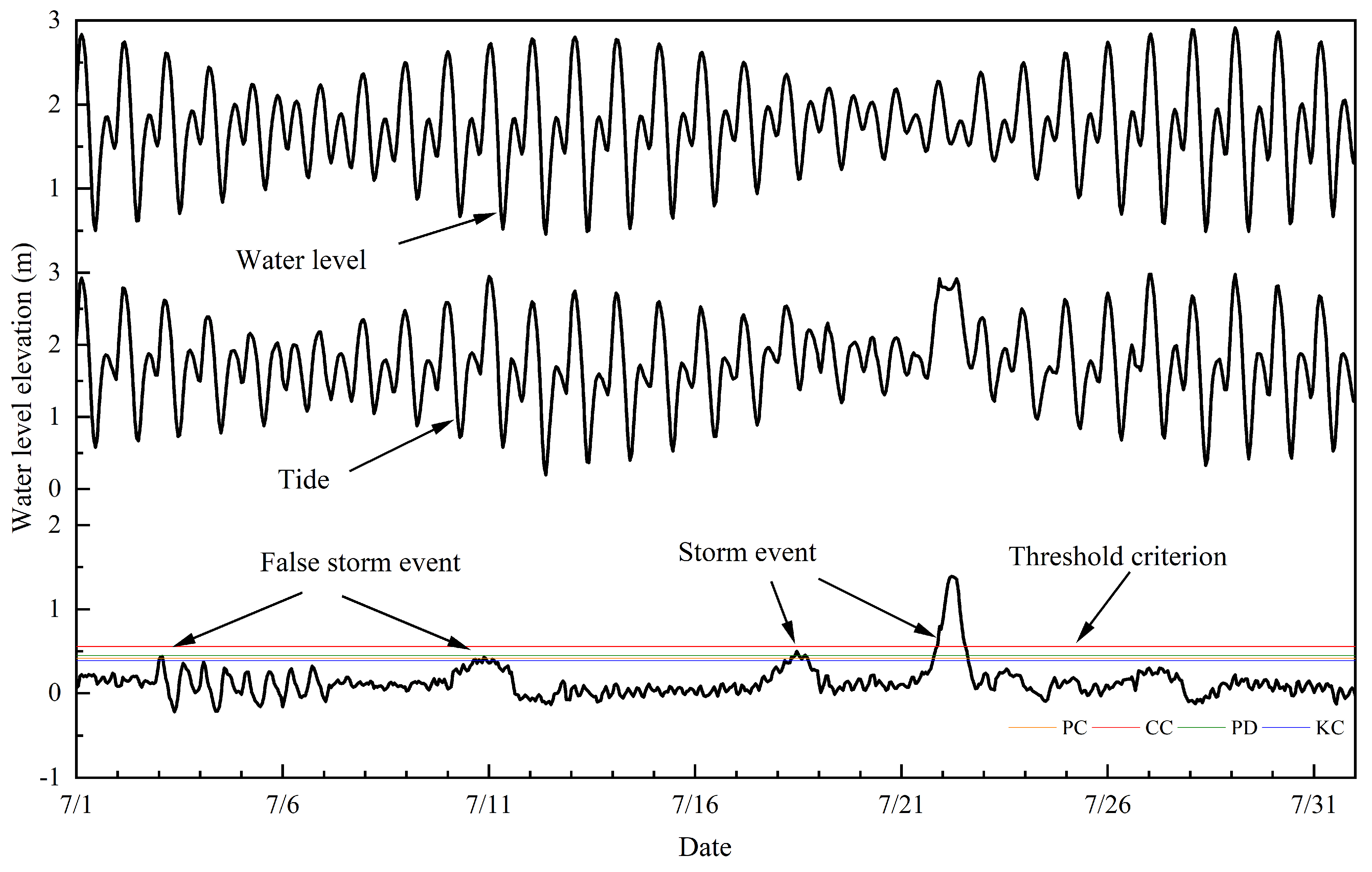
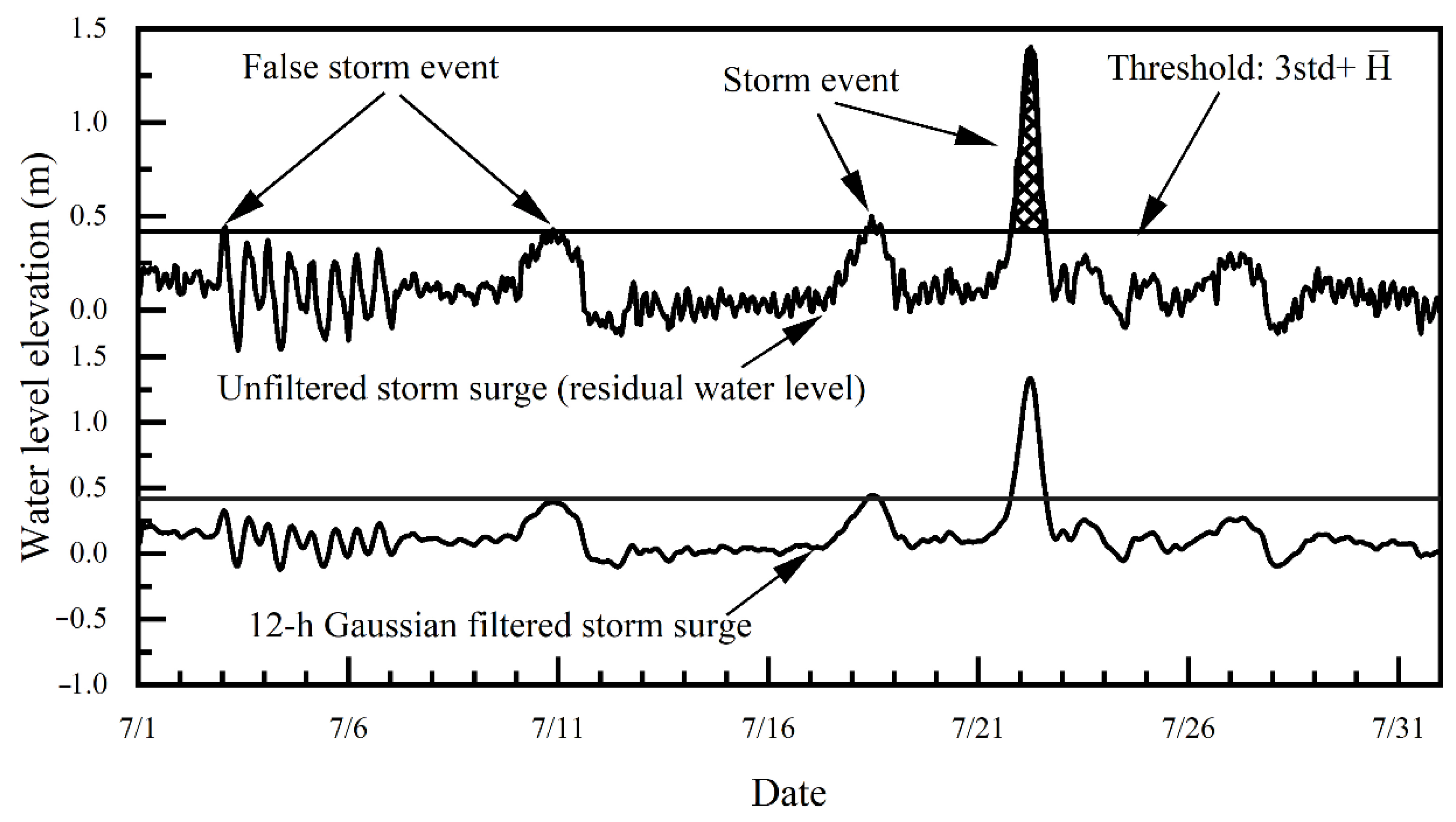
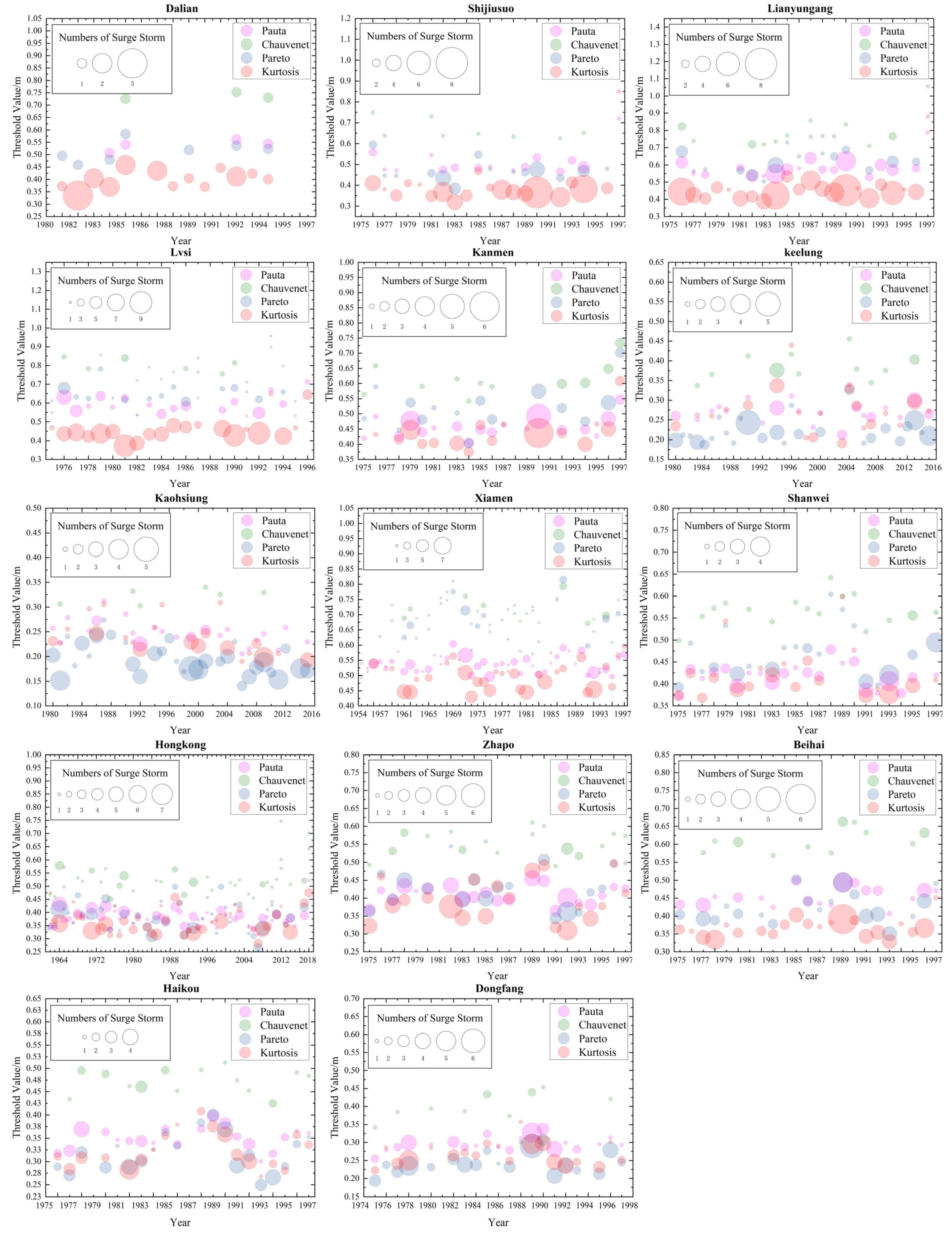
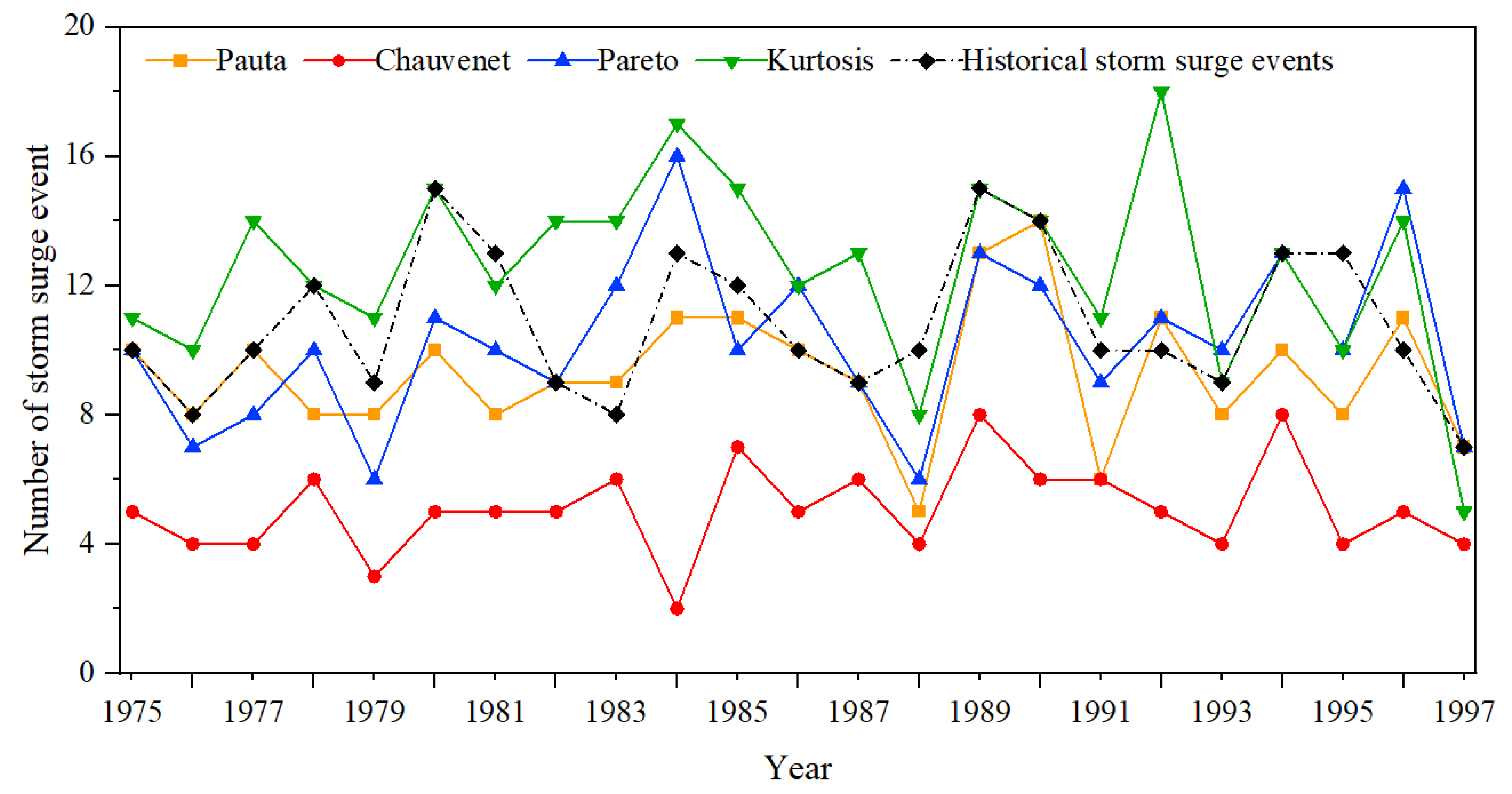
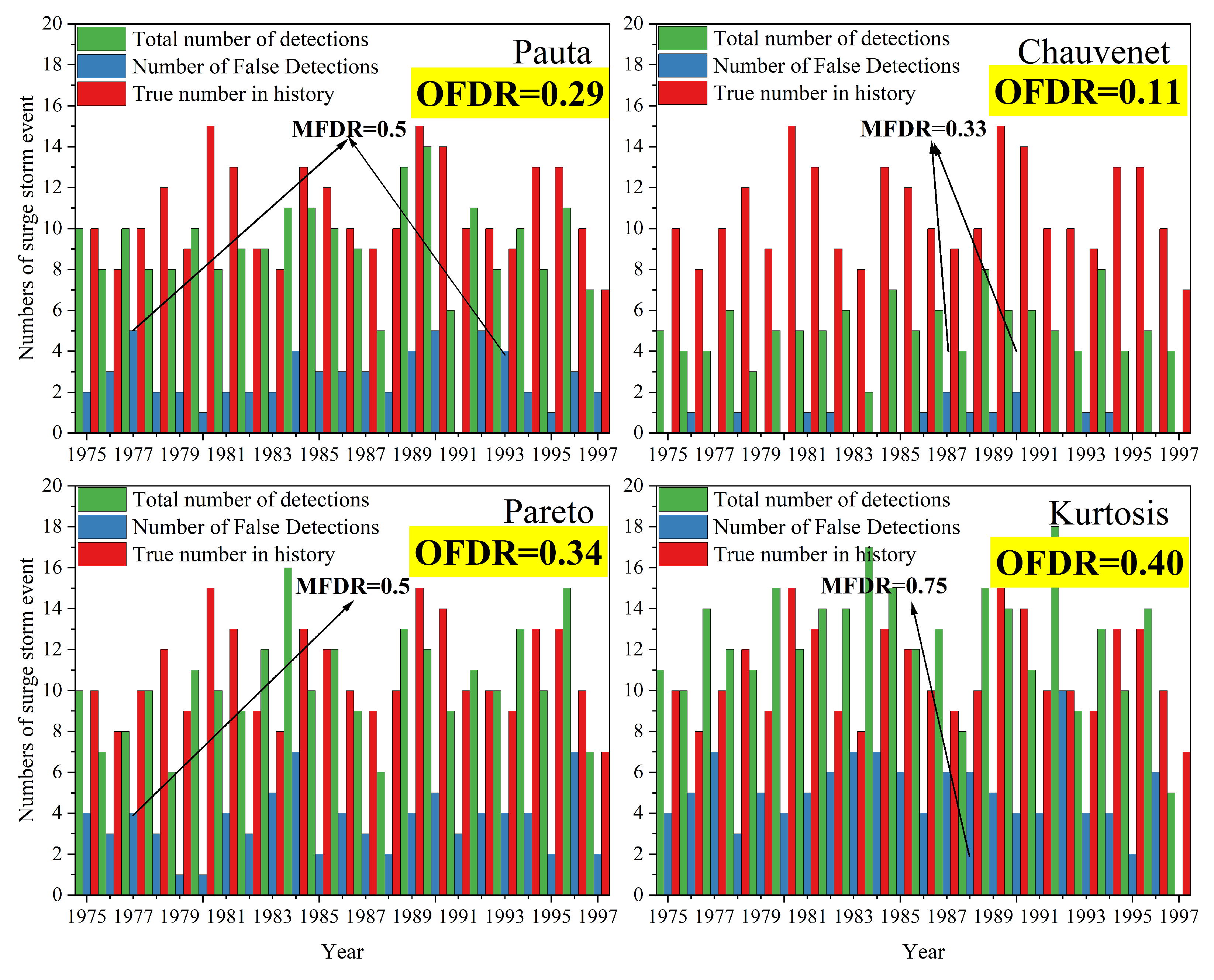
| TG_Name | Province | PC | CC | PD | KC | ||||
|---|---|---|---|---|---|---|---|---|---|
| Threshold | Storm-Surge Number | Threshold | Storm-Surge Number | Threshold | Storm-Surge Number | Threshold | Storm-Surge Number | ||
| Dalian | Liaoning | 0.5708 (0.5809) | 4 (4) | 0.7657 (0.7478) | 3 (3) | 0.5396 (0.5259) | 7 (7) | 0.4039 (0.4288) | 20 (20) |
| Shijiusuo | Shandong | 0.4924 (0.5032) | 20 (25) | 0.6605 (0.6781) | 6 (8) | 0.4724 (0.4774) | 25(29) | 0.379 (0.4015) | 59 (70) |
| Lianyungang | Jiangsu | 0.5698 (0.5789) | 37 (44) | 0.7644 (0.7805) | 12 (16) | 0.6332 (0.6289) | 25 (30) | 0.4491 (0.4654) | 67 (85) |
| Lusi | Jiangsu | 0.5787 (0.5817) | 40 (58) | 0.7763 (0.7719) | 17 (22) | 0.6702 (0.65) | 29 (41) | 0.456 (0.4529) | 88 (116) |
| Kanmen | Zhejiang | 0.4439 (0.4503) | 26 (36) | 0.5955 (0.6137) | 11 (15) | 0.5073 (0.5189) | 20 (27) | 0.4425 (0.4564) | 29 (38) |
| Keelung | Taiwan | 0.2664 (0.2671) | 12 (25) | 0.3574 (0.3691) | 7 (13) | 0.2205 (0.214) | 27 (51) | 0.2881 (0.2717) | 11 (24) |
| Kaohsiung | Taiwan | 0.2634 (0.2497) | 14 (28) | 0.3534 (0.3357) | 3 (6) | 0.2195 (0.2008) | 33 (80) | 0.282 (0.245) | 16 (40) |
| Xiamen | Fujian | 0.5358 (0.5366) | 37 (101) | 0.7189 (0.7211) | 14 (34) | 0.6921 (0.6877) | 17 (43) | 0.5217 (0.5249) | 50 (119) |
| Shanwei | Guangdong | 0.4138 (0.4145) | 32 (42) | 0.555 (0.5592) | 12 (17) | 0.4601 (0.4609) | 25 (33) | 0.4418 (0.417) | 29 (39) |
| Hongkong | Hongkong | 0.3809 (0.3802) | 29 (104) | 0.511 (0.514) | 11 (46) | 0.3903 (0.3946) | 33 (101) | 0.3873 (0.39) | 39 (122) |
| Zhapo | Guangdong | 0.414 (0.4133) | 47 (62) | 0.5555 (0.5495) | 16 (22) | 0.4471 (0.4432) | 40 (53) | 0.4076 (0.3973) | 51 (66) |
| Beihai | Guangxi | 0.4525 (0.4504) | 25 (32) | 0.607 (0.6082) | 12 (14) | 0.4234 (0.4227) | 30 (39) | 0.3674 (0.3681) | 39 (51) |
| Haikou | Hainan | 0.3501 (0.3486) | 32 (42) | 0.4697 (0.468) | 16 (20) | 0.3208 (0.3202) | 43 (52) | 0.3302 (0.3278) | 37 (47) |
| Dongfang | Hainan | 0.2989 (0.2961) | 30 (40) | 0.401 (0.3978) | 9 (11) | 0.2489 (0.2466) | 45 (60) | 0.2738 (0.2685) | 37 (50) |
| Year | PC | CC | PD | KC | ||||||||
|---|---|---|---|---|---|---|---|---|---|---|---|---|
| P | R | F1 | P | R | F1 | P | R | F1 | P | R | F1 | |
| 1975 | 0.80 | 0.80 | 0.80 | 1.00 | 0.50 | 0.67 | 0.60 | 0.60 | 0.60 | 0.64 | 0.70 | 0.67 |
| 1976 | 0.63 | 0.63 | 0.63 | 0.75 | 0.38 | 0.50 | 0.57 | 0.50 | 0.53 | 0.50 | 0.63 | 0.56 |
| 1977 | 0.50 | 0.50 | 0.50 | 1.00 | 0.40 | 0.57 | 0.50 | 0.40 | 0.44 | 0.50 | 0.70 | 0.58 |
| 1978 | 0.75 | 0.50 | 0.60 | 0.83 | 0.42 | 0.56 | 0.70 | 0.58 | 0.64 | 0.75 | 0.75 | 0.75 |
| 1979 | 0.75 | 0.67 | 0.71 | 1.00 | 0.33 | 0.50 | 0.83 | 0.56 | 0.67 | 0.55 | 0.67 | 0.60 |
| 1980 | 0.90 | 0.60 | 0.72 | 1.00 | 0.33 | 0.50 | 0.91 | 0.67 | 0.77 | 0.73 | 0.73 | 0.73 |
| 1981 | 0.75 | 0.46 | 0.57 | 0.80 | 0.31 | 0.44 | 0.60 | 0.46 | 0.52 | 0.58 | 0.54 | 0.56 |
| 1982 | 0.78 | 0.78 | 0.78 | 0.80 | 0.44 | 0.57 | 0.67 | 0.67 | 0.67 | 0.57 | 0.89 | 0.70 |
| 1983 | 0.78 | 0.88 | 0.82 | 1.00 | 0.75 | 0.86 | 0.58 | 0.88 | 0.70 | 0.50 | 0.88 | 0.64 |
| 1984 | 0.64 | 0.54 | 0.58 | 1.00 | 0.15 | 0.27 | 0.56 | 0.69 | 0.62 | 0.59 | 0.77 | 0.67 |
| 1985 | 0.73 | 0.67 | 0.70 | 1.00 | 0.58 | 0.74 | 0.80 | 0.67 | 0.73 | 0.60 | 0.75 | 0.67 |
| 1986 | 0.70 | 0.70 | 0.70 | 0.80 | 0.40 | 0.53 | 0.67 | 0.80 | 0.73 | 0.67 | 0.80 | 0.73 |
| 1987 | 0.67 | 0.67 | 0.67 | 0.67 | 0.44 | 0.53 | 0.67 | 0.67 | 0.67 | 0.54 | 0.78 | 0.64 |
| 1988 | 0.60 | 0.30 | 0.40 | 0.75 | 0.30 | 0.43 | 0.67 | 0.40 | 0.50 | 0.25 | 0.20 | 0.22 |
| 1989 | 0.69 | 0.60 | 0.64 | 0.88 | 0.47 | 0.61 | 0.69 | 0.60 | 0.64 | 0.67 | 0.67 | 0.67 |
| 1990 | 0.64 | 0.64 | 0.64 | 0.67 | 0.29 | 0.40 | 0.58 | 0.50 | 0.54 | 0.71 | 0.71 | 0.71 |
| 1991 | 1.00 | 0.60 | 0.75 | 1.00 | 0.60 | 0.75 | 0.67 | 0.60 | 0.63 | 0.64 | 0.70 | 0.67 |
| 1992 | 0.55 | 0.60 | 0.57 | 1.00 | 0.50 | 0.67 | 0.64 | 0.70 | 0.67 | 0.44 | 0.80 | 0.57 |
| 1993 | 0.50 | 0.44 | 0.47 | 0.75 | 0.33 | 0.46 | 0.60 | 0.67 | 0.63 | 0.56 | 0.56 | 0.56 |
| 1994 | 0.80 | 0.62 | 0.70 | 0.88 | 0.54 | 0.67 | 0.69 | 0.69 | 0.69 | 0.69 | 0.69 | 0.69 |
| 1995 | 0.88 | 0.54 | 0.67 | 1.00 | 0.31 | 0.47 | 0.80 | 0.62 | 0.70 | 0.80 | 0.62 | 0.70 |
| 1996 | 0.73 | 0.80 | 0.76 | 1.00 | 0.50 | 0.67 | 0.53 | 0.80 | 0.64 | 0.57 | 0.80 | 0.67 |
| 1997 | 0.71 | 0.71 | 0.71 | 1.00 | 0.57 | 0.73 | 0.71 | 0.71 | 0.71 | 1.00 | 0.71 | 0.83 |
| Overall | 0.71 | 0.61 | 0.66 | 0.89 | 0.42 | 0.57 | 0.66 | 0.62 | 0.64 | 0.60 | 0.69 | 0.65 |
| Storm-Surge Level | Number in the Book | PC | CC | PD | KC | ||||
|---|---|---|---|---|---|---|---|---|---|
| DN | DR | DN | DR | DN | DR | DN | DR | ||
| Red | 15 | 15 | 1 | 13 | 0.87 | 12 | 0.8 | 15 | 1 |
| Orange | 36 | 33 | 0.92 | 26 | 0.72 | 32 | 0.89 | 31 | 0.86 |
| Yellow | 27 | 23 | 0.85 | 20 | 0.74 | 24 | 0.89 | 23 | 0.85 |
| Blue | 6 | 5 | 0.83 | 4 | 0.67 | 5 | 0.83 | 5 | 0.83 |
| Overall | 84 | 76 | 0.90 | 63 | 0.75 | 73 | 0.87 | 74 | 0.88 |
Disclaimer/Publisher’s Note: The statements, opinions and data contained in all publications are solely those of the individual author(s) and contributor(s) and not of MDPI and/or the editor(s). MDPI and/or the editor(s) disclaim responsibility for any injury to people or property resulting from any ideas, methods, instructions or products referred to in the content. |
© 2023 by the authors. Licensee MDPI, Basel, Switzerland. This article is an open access article distributed under the terms and conditions of the Creative Commons Attribution (CC BY) license (https://creativecommons.org/licenses/by/4.0/).
Share and Cite
Ma, P.; Li, G. Comparison and Analysis of Detection Methods for Typhoon-Storm Surges Based on Tide-Gauge Data—Taking Coasts of China as Examples. Int. J. Environ. Res. Public Health 2023, 20, 3253. https://doi.org/10.3390/ijerph20043253
Ma P, Li G. Comparison and Analysis of Detection Methods for Typhoon-Storm Surges Based on Tide-Gauge Data—Taking Coasts of China as Examples. International Journal of Environmental Research and Public Health. 2023; 20(4):3253. https://doi.org/10.3390/ijerph20043253
Chicago/Turabian StyleMa, Peipei, and Guosheng Li. 2023. "Comparison and Analysis of Detection Methods for Typhoon-Storm Surges Based on Tide-Gauge Data—Taking Coasts of China as Examples" International Journal of Environmental Research and Public Health 20, no. 4: 3253. https://doi.org/10.3390/ijerph20043253
APA StyleMa, P., & Li, G. (2023). Comparison and Analysis of Detection Methods for Typhoon-Storm Surges Based on Tide-Gauge Data—Taking Coasts of China as Examples. International Journal of Environmental Research and Public Health, 20(4), 3253. https://doi.org/10.3390/ijerph20043253






